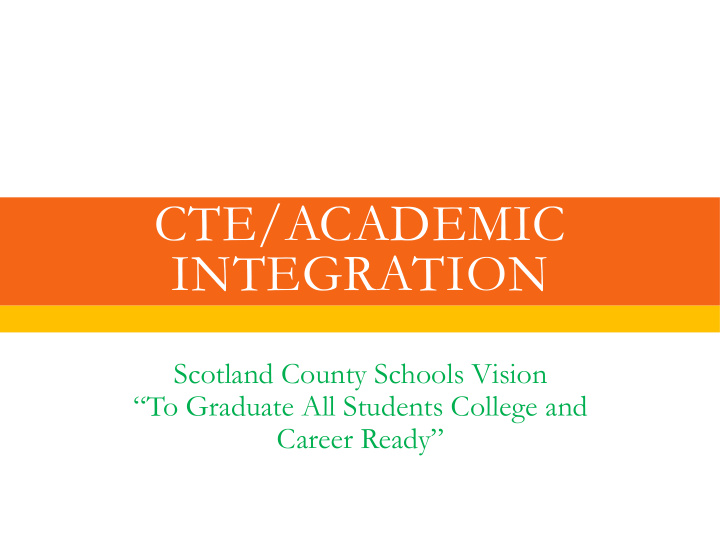



CTE/ACADEMIC INTEGRATION Scotland County Schools Vision “To Graduate All Students College and Career Ready”
DESIRED OUTCOMES By the end of this workshop we will: Understand Lexile Levels in Reading and Quantile Framework for Math Understand the rationale of developing CTE Curriculum Maps Create one CTE Curriculum Map for an upcoming unit/lesson plan (See Attachment) Have a guide for accessing additional literacy and numeracy resources to improve academic performance in CTE
LEXILE LEVELS BY CLUSTER Career Cluster Lexile Measure Career Cluster Lexile Measure Agriculture & Natural Resources 1270-1510L Human Services 1050-1200L Architecture & Construction 1210-1340L Law & Public Safety 1420-1740L Arts, Audiovisual Technology & 1100-1190L Manufacturing 1200-1310L Communications Business & Administration 1210-1310L Retail/Wholesale Sales & Service 1180-1270L Education and Training 1320-1370L Scientific 1190-1250L Research/Engineering Health Science 1260-1300L Transportation, Distribution 1170-1350L & Logistics Hospitality & Tourism 1230-1260L
EOG MATHEMATICS/NC READY EOC MATH I PERFORMANCE STANDARDS IN THE QUANTILE MEASURE. Limited Partial Sufficient Solid Superior Command Command Command Command Command Grade 3 425Q and Below 430Q to 605Q 610Q to 675Q 680Q to 880Q 885Q and Above 4 550Q and Below 555Q to 720Q 725Q to 760Q 765Q to 945Q 950Q and Above 5 600Q and Below 605Q to 770Q 775Q to 815Q 820Q to 1005Q 1010Q and Above 6 755Q and Below 760Q to 905Q 910Q to 945Q 950Q to 1120Q 1125Q and Above 7 805Q and Below 810Q to 955Q 960Q to 995Q 1000Q to 1160Q 1165Q and Above 8 920Q and Below 925Q to 1090Q 1095Q to 1135Q 1140Q to 1330Q 1335Q and Above Math I 890Q and Below 895Q to 1015Q 1020Q to 1075Q 1080Q to 1305Q 1310Q and Above
SAMPLE STUDENT (10 TH GRADE FEMALE) Predicted to Score 90.2% on the Foods I Postassessment “Middle Range”
ACADEMIC/CTE INTEGRATION
WHY INTEGRATE? NCLB requires integration to provide rigorous curriculum to raise student achievement New Perkins legislation requires academic integration and rigor Enables students to know why they need to know this and how they can use it
INSTRUCTIONAL INTEGRATION Proven strategy for helping students see connections between Academic skills required to learn and World of work where required to apply them Motivation to learn is improved Better prepared for employment
DEFINING RIGOR AND WHAT IT LOOKS LIKE Barbara Blackburn defined rigor as creating an environment in which each student is expected to learn at high levels, each student is supported so that he or she can learn at high levels, and each student demonstrates learning at high levels (Blackburn, 2008). Rigor includes our basic philosophy of learning – we expect our students to demonstrate not only content mastery, but applied skills and critical thinking about the disciplines being taught. Rigor + Motivation + Engagement = SUCCESS! http://www.barbarablackburnonline.com/
COMPONENTS OF RIGOR Assists students in fulfilling predetermined outcomes and competencies by challenging them with high expectations. Essential components of rigor in the classroom: Content acquisition Critical thinking Relevance Integration Application of concepts Long term retention Responsibility
TEACHER ACTIVITIES TO INCREASE RIGOR CURRICULUM MAPPING Curriculum maps document the topics and skills that have been planned, taught, and learned, helping teachers determine interventions and next steps. Curriculum maps help groups of teachers compare what has been covered in other grades, revealing repetition and gaps in the curriculum across disciplines, and highlighting strengths and weaknesses in aligning curriculum with district and state standards. Curriculum mapping fosters and supports collaboration among teachers, and promotes more effective instruction.
AUTHENTIC PROBLEM SOLVING When instruction is academically rigorous, students actively explore, research and solve complex problems to develop a deep understanding of core academic concepts. Increasing rigor does not mean more and longer assignments, rather, it means time and opportunity for students to develop and apply habits of mind as they navigate sophisticated and reflective learning experiences. Students weigh evidence, consider varying viewpoints, see connections, identify patterns, evaluate outcomes, speculate on possibilities and assess value. Students demonstrate what they know
CURRICULUM MAPS Curriculum maps cover a wide range of important curricular activities. Organizes information into an easily accessed visual that presents a timeline of instruction by teacher and course. Curricular maps can be simple or elaborate
WHY CREATE A CURRICULUM MAP? Curriculum maps help to answer the questions regarding what is taught in the classroom. Curriculum maps provide the educational community with a look into the curriculum to understand what specific information will be taught A curriculum map provides insight into the big picture, and responsible use of the information contained by a curriculum map can strengthen instruction school wide. http://home.earthlink.net/~carozza/hhj.ht
PLEASE COMPLETE EVALUATION
Recommend
More recommend